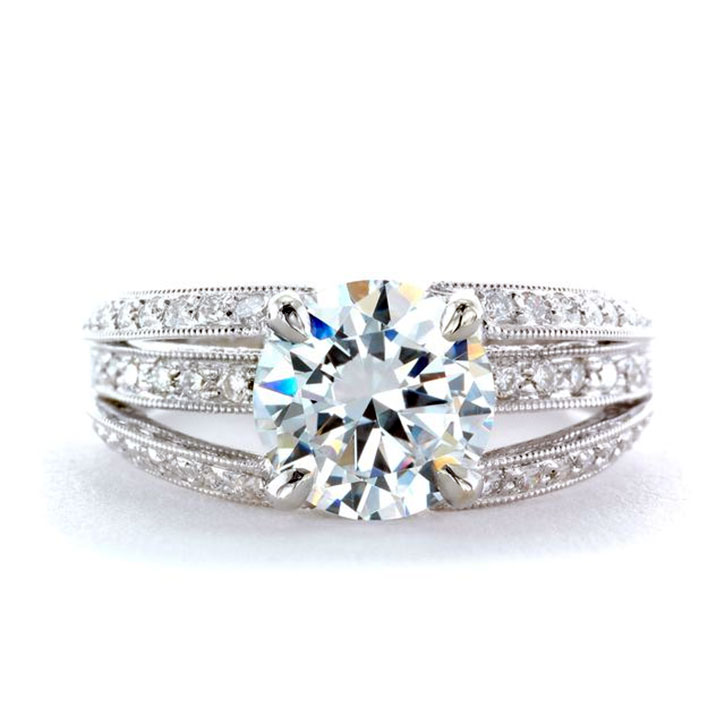Diamonds vs Moissanite | Color, Quality, Hardness, and Price
There seem to be two camps of people on the issue of diamonds vs. Moissanite. Some think Moissanite is an incredible alternative to a diamond for a plethora of reasons. Others think they could never hold a candle to the beauty of a natural diamond. The truth is, even though most people would never be able to tell the difference between a Moissanite stone or a diamond at first glance, there are some significant differences between the two. Whether these differences add up to making Moissanite your first choice for an engagement ring is a subject that is heavily debated and entirely up to the individual. Here are some of the main characteristics to consider:

Natural vs. Manmade
Moissanite is a naturally occurring stone, but the Moissanite you see on the market today is not natural.
In fact, natural Moissanite is actually significantly more rare than diamonds. Even though it was first discovered in 1893 by Henri Moissan, the existence of Moissanite on earth apart from in meteorites was contested and controversial even as recently as 1986. So that leaves natural Moissanite a jewelry impossibility.
Silicon carbide, which is what Moissanite is made of, has been synthesized for over 100 years, but it wasn’t until 1998 that gem quality synthetic Moissanite became available to the public through a process perfected by Charles & Colvard. So is the fact that Moissanite is a manmade jewel a pro or a con? I guess it depends on your perspective. Some think harsh mining practices make purchasing a diamond irresponsible. An inexpensive manmade stone that was made with integrity, however? Given the other four differences, one might think Moissanite, despite lack of rarity factor, isn’t so bad. Do remember, diamonds are beautiful and usually natural, but they are not as rare as the market and price tag wants you to think.
Read More: Gemstone Advice – Facts About Gemstones Before You Buy Jewelry
Durability
Diamond and Moissanite are durable stones. Moissanite is arguably the next best stone when it comes to the Mohs Scale of Hardness, ranking 9.25. A diamond has a Mohs hardness ranking of 10. Both diamonds and Moissanite can be scratched, but diamonds are going to be a little bit more resistant to this.
Quality
Two things come to mind with the quality of Moissanite: color and clarity. The clarity is always very good to perfect on Moissanite because it’s manufacturing is highly controlled and monitored. The inclusions you would find in a diamond, you won’t find in Moissanite. The color of Moissanite is one factor that some people are turned off by. The larger the stone, the more noticeable the color is which can range from light green to grey to yellow. However, one could argue that many lower quality diamonds, possibly in your price range, will also have a tint of color.
Sparkle Factor
One benefit or con depending on your bling preference is the refractive index of Moissanite. The manmade gem has a refractive index of 2.65-2.69 which is greater than a diamond that has a refractive index around 2.417. Basically, a refractive index measures how long it takes for light to travel through an object. In Moissanite’s case, the higher score means the longer the light will be bouncing through the facets of the stone, allowing the stone ultimately to reflect more light and thus be more brilliant. That is as simple of a way as I could think to explain it. So if you like sparkle, the extra flash from Moissanite may make it the choice for you.
Cost
By far the most significant difference between diamond and Moissanite is the cost, especially in larger stones. Don’t let the inexpensive price tag fool you. Moissanite is actually among the most expensive diamond simulants on the market, especially when you compare it to cubic zirconia. This is because of the complex and labor-intensive proprietary process that goes into its manufacture. Compared to diamonds, they can be as much as 95% less expensive.
Read More: Amber Gemstones Facts & Advice – How to Tell if Amber is Real or Fake

 Citizen Eco-Drive Chronograph Review
Citizen Eco-Drive Chronograph Review